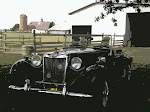Betsy was painting one day on our "patio" in the back and a man came by and he was the archaeologist for Monument Valley, Canyon de Chelly, and Hubbell Trading Post National Historic Site. I invited him into the hogan, where he'd never been, and ask him to look at the fireplace artifacts. He immediately focused on the black and white bowl and drinking cup and said they were Kayenta Black on White and probably dated to 1100 AD.
We also made two trips to Window Rock which is the capital of the Navajo Nation. I wanted to go because Tony Hillerman always talked about it in his books and I wanted to see it. In a park there is a monument remembering the Navajo Code Talkers of WW II. The "code" they used was the Navajo language and it was the only code the Japanese couldn't break. The U.S. government kept it secret for years, in case it would be needed again. Finally in the 1970's they recognized the Code Talkers for their service and the many lives they saved.
I mentioned before that at 6 PM the trading post would close and everyone would go home except Betsy and I and one other site worker. A couple of evenings we walked around all the old buildings without anyone there and in the quiet you could feel the history and people of this place.
Another piece of information we learned was that Hubbell named this area Pueblo Colorado for the stream and wash that bordered the post property. However, when mail service finally reached this part of Arizona Territory all of the mail sent to him ended up in, you guessed it, Pueblo, Colorado. So he renamed the settlement Ganado, after Ganado Mucho who was a local chief. A son of Ganado Mucho was Many Horses who was a life long friend of Hubbells. To the west of the post is a hill where several of the Hubbells are buried. All have headstones, except Mr. Hubbell, and his son Roman, who chose to be buried in the Navajo manner. With them is Many Horses.
One of our favorite people was James, a maintenance worker. He was Navajo of course and just a delight to be around, always a wealth of information and had a great sense of humor. One day he must have been in charge of a group of local teenagers who were doing work at the site, and he brought them by so they could meet Betsy. He told me that he wanted the young people to have opportunities to learn from others. When we were leaving I ask him to tell us how to get to Holbrook on the back roads and he suggested I-15. Up there I doesn't mean Interstate it means Indian. (It was a beautiful road with towering mesa's, and wide open spaces.) We shook hands, and with a gleam in his eye, he said, "If you need any help and you're north of Interstate 40 you talk to a Navajo, but if you're south of Interstate 40 you'll have to call them Apaches". James is the worker who takes care of the hogan and back patio. I left him a little creature that I'd put together out of rocks and a chicken feather. I think he'll enjoy it.






.JPG)























